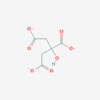Description
citric acid, C6H7O7-3, is a tricarboxylic acid trianion, intermediate of the TCA, obtained by deprotonation of the three carboxy groups of citric acid. Citrate is formed from oxaloacetate and acetyl-CoA through the catalytic activity of the citrate synthase. In the TCA, citrate forms isocitrate by the activity of the aconitase. Citrate can be transported out of the mitochondria by the tricarboxylate transport, situated in the inner mitochondrial membrane. The transport occurs as an antiport of malate from the cytosol and it is a key process for fatty acid synthesis and oxaloacetate in the cytosol.
Reference: Gnaiger 2014 MitoPathways
MitoPedia topics: Substrate and metabolite

